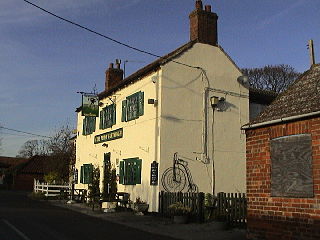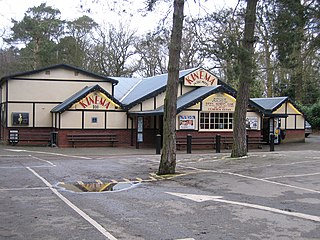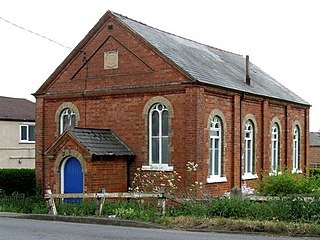
Horncastle is a market town and civil parish in the East Lindsey district in Lincolnshire, England. It is 17 miles (27 km) east of Lincoln. Its population was 6,815 at the 2011 census and estimated at 7,123 in 2019. A section of the ancient Roman walls remains.

Tattershall is a village and civil parish in the East Lindsey district of Lincolnshire, England. It is situated on the A153 Horncastle to Sleaford road, 1 mile (1.6 km) east from the point where that road crosses the River Witham at Tattershall Bridge. At its eastern end, Tattershall adjoins the town of Coningsby, with the two being separated by the River Bain and is 1 mile (1.6 km) south-east from the hamlet Tattershall Thorpe.

The River Bain is a river in Lincolnshire, England, and a tributary of the River Witham.

Coningsby is a town and civil parish in the East Lindsey district in Lincolnshire, England, it is situated on the A153 road, adjoining Tattershall on its western side, 13 miles (21 km) north west of Boston and 8 miles (13 km) south west from Horncastle.
The Horncastle Canal was a broad canal which ran 11 miles (18 km) from the River Witham to Horncastle in Lincolnshire, England, through twelve locks largely following the course of the River Bain. The canal opened in 1802, and was abandoned for navigation in 1889.

Bardney is a village and civil parish in the West Lindsey district of Lincolnshire, England. The population of the civil parish was 1,643 at the 2001 census increasing to 1,848 at the 2011 census. The village sits on the east bank of the River Witham, 9 miles (14 km) east of Lincoln.

Timberland is a village in the North Kesteven district of Lincolnshire, England. The population of the civil parish at the 2011 census was 578. It is situated 9 miles (14 km) north-east from Sleaford, and on the Timberland Fen. Its closest neighbouring village is Martin, less than 1 mile (1.6 km) to the north.

Woodhall Spa is a former spa town and civil parish in the East Lindsey district of Lincolnshire, England, on the southern edge of the Lincolnshire Wolds, 6 miles (10 km) south-west of Horncastle, 23 miles (37 km) west of Skegness, 15 miles (24 km) east-south-east of Lincoln and 17 miles (27 km) north-west of Boston. It is noted for its mineral springs, historic cinema and its Second World War association with the RAF 617 Squadron, commonly referred to as 'The Dambusters'.
Kirkstead Bridge is a concrete bridge in central Lincolnshire over the River Witham on the B1191.

Kirkstead Abbey is a former Cistercian monastery in Kirkstead, Lincolnshire, England.

The church of St Leonard's Without is a small chapel built between 1230 and 1240 in the parish of Kirkstead, Lincolnshire, close to Woodhall Spa.

Woodhall Junction railway station is a former station in Woodhall, Lincolnshire. It served as a junction where several different lines met, none of which are still open.

Woodhall Spa railway station was a station in Woodhall Spa, Lincolnshire on a small branch line running north from Woodhall Junction to Horncastle. Both the station and the line are now closed.

The Lincolnshire loop line was a railway built by the Great Northern Railway, that linked Peterborough to Gainsborough via Spalding, Boston and Lincoln. It ran through the counties of Lincolnshire and Northamptonshire
The Horncastle and Kirkstead Junction Railway was a seven mile long single track branch railway line in Lincolnshire, England, that ran from Horncastle to Woodhall Junction on the Great Northern Railway (GNR) line between Boston and Lincoln. There was one intermediate station, Woodhall Spa.

Dogdyke is a hamlet in the North Kesteven district of Lincolnshire, England. It is situated approximately 2 miles (3 km) south from Tattershall, and at the confluence of the Rivers Bain and Witham, and close to where the River Slea joins the Witham.

Stixwould is a small village in the civil parish of Stixwould and Woodhall, in the East Lindsey district of Lincolnshire, England.

Wildmore is a civil parish in the East Lindsey district of Lincolnshire, England. It is situated approximately 9 miles (14 km) north-west from the town of Boston and 11 miles (18 km) south from Horncastle.

Langrick Bridge is a village in the civil parish of Holland Fen with Brothertoft in the Borough of Boston, Lincolnshire, England. The village is in the Lincolnshire Fens, 5 miles (8 km) north-west of Boston and 24 miles (40 km) south-east of Lincoln. It is at the southern side of the bridge of the same name which spans the River Witham. At the north side of the bridge the settlement is in the civil parish of Langriville. The southern boundary of the village of Langrick is 200 yards (180 m) north from the bridge.

Martin Dales is a hamlet in the civil parish of Martin in North Kesteven, Lincolnshire, England. It is located to the east of Martin and west of Woodhall Spa.



















